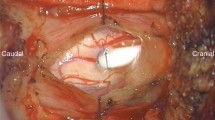Abstract
Background
Surgical treatment of syringomyelia is directed at the reconstruction of the subarachnoid space and restoration normal cerebrospinal fluid flow. Direct intervention on the syrinx is a rescue procedure and should be offered to patients with refractory syringomyelia.
Methods
We provide an overview on indications and technique of syringopleural shunt (SPS). The procedure involves the connection of syrinx with the pleural space using a lumboperitoneal shunt. The occurrence of a negative pressure inside the pleural compartment offers an appropriate gradient for drainage from the syrinx.
Conclusions
The SPS allows for a safe and effective treatment of persistent syringomyelia when management of the underlying cause does not yield substantial improvement.



Similar content being viewed by others
Data availability
Not applicable.
Code availability
Not applicable.
References
Cacciola F, Capozza M, Perrini P, Nenedetto N, Di Lorenzo N (2009) Syringopleural shunt as a rescue procedure in patients with syringomyelia refractory to restoration of cerebrospinal fluid flow. Neurosurgery 65(3):471–476
Ciaramitaro P, Massimi L, Bertuccio A, Solari A, Farinotti M, Peretta P, Saletti V, Chiapparini L, Barbanera A, Garbossa D, Bolognese P, Brodbelt A, Celada C, Cocito D, Curone M, Devigli G, Erbetta A, Ferraris M, Furlanetto M, Gilanton M, Jallo G, Karadjova M, Klekamp J, Massaro F, Morar S, Parker F, Perrini P, Poca MA, Sahuillo J, Stoodley M, Talamonti G, Triulzi F, Valentini MC, Visocchi M, Valentini L (2022) Diagnosis and treatment of Chiari malformation and syringomyelia in adults: international consensus document. Neurol Sci 43(2):1327–1342
Fan T, Zhao XG, Shao H, Liang C, Wang YQ, Gai QF, Zhang F (2015) Treatment of selected syringomyelias with syringo-pleura shunt: the experience with a consecutive 26 cases. Clin Neurol Neurosurg 137:50–56
Miyasaka K, Asano T, Ushikoshi S, Hida K, Koyanagi I (2000) Vascular anatomy of the spinal cord and classification of spinal arteriovenous malformations. Interv Neurorad 6(Suppl1):195–198
Perrini P, Benedetto N, Guidi E, Di Lorenzo N (2009) Transoral approach and its superior extensions to the craniovertebral junction malformations: surgical strategies and results. Neurosurgery 64(5 Suppl 2):331–342
Perrini P, Anania A, Cagnazzo F, Benedetto N, Morganti R, Di Carlo DT (2021) Radiological outcome after surgical treatment of syringomyelia-Chiari I complex in adults: a systematic review and meta-analysis. Neurosurg Rev 44(1):177–187
Rothrock RJ, Lu VM, Levi AD (2021) Syrinx shunts for syringomyelia: a systematic review and meta-analysis of syringosubarachnoid, syringoperitoneal, and syringopleural shunting. J Neurosurg Spine 35:535–545
Torkoglu E, Kertmen H, Uluc K, Akture E, Gurer B, Cikla U, Salamat S, Baskaya MK (2015) Microsurgical anatomy of the posterior median septum of the human spinal cord. Clin Anat 28:45–51
Williams B, Page N (1987) Surgical treatment of syringomyelia with syringopleural shunting. Br J Neurosurg 1(1):63–80
Author information
Authors and Affiliations
Contributions
All authors contributed to the study conception and design. Material preparation, data collection, and analysis were performed by Alberto Vercelli, Nicola Benedetto, and Davide Tiziano Di Carlo. The first draft of the manuscript was written by Paolo Perrini and all authors commented on previous versions of the manuscript. All authors read and approved the final manuscript.
Corresponding author
Ethics declarations
Ethical approval
Not applicable
Consent to participate
Not required
Consent for publication
Not required
Conflict of interest
The authors declare no competing interests.
Additional information
Publisher's note
Springer Nature remains neutral with regard to jurisdictional claims in published maps and institutional affiliations.
Key points
1. SPS is indicated in refractory syringomyelia after failure of surgical procedures that address the underlying cause.
2. Syringomyelia persistence after foramen magnum decompression for CMI is the main indication for SPS.
3. The laminectomy site is centered at the widest and most caudal portion of the syrinx as demonstrated by the MRI.
4. Intraoperative neurophysiological monitoring with MEP and SSEPs is required to minimize postoperative neurological complications.
5. Myelotomy should not exceed 3 mm and is performed in an area with a paucity of blood vessels along the midline.
6. The holes of proximal tip catheter should line within syringomyelia cavity to avoid syrinx persistence and low-pressure headache.
7. The paramedian thoracic incision is performed below the tip of the scapula to avoid dislodgment of the catheter.
8. The distal end of the catheter should be shortened to the appropriate length to avoid pleuritic chest pain.
9. Postoperative pleural effusion is a common finding at the postoperative chest X-ray and is generally self-limiting.
10. Postoperative shrinkage of the syrinx is observed at follow-up MRI in the majority of patients.
Supplementary Information
Below is the link to the electronic supplementary material.
Supplementary file1 (MP4 426266 KB)
Rights and permissions
Springer Nature or its licensor (e.g. a society or other partner) holds exclusive rights to this article under a publishing agreement with the author(s) or other rightsholder(s); author self-archiving of the accepted manuscript version of this article is solely governed by the terms of such publishing agreement and applicable law.
About this article
Cite this article
Perrini, P., Benedetto, N., Vercelli, A. et al. Syringopleural shunt for refractory syringomyelia: how I do it. Acta Neurochir 165, 3039–3043 (2023). https://doi.org/10.1007/s00701-023-05654-y
Received:
Accepted:
Published:
Issue Date:
DOI: https://doi.org/10.1007/s00701-023-05654-y




